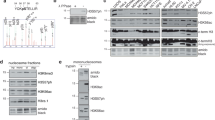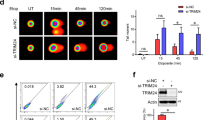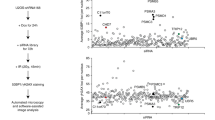Abstract
DNA double-stranded breaks present a serious challenge for eukaryotic cells. The inability to repair breaks leads to genomic instability, carcinogenesis and cell death. During the double-strand break response, mammalian chromatin undergoes reorganization demarcated by H2A.X Ser 139 phosphorylation (γ-H2A.X). However, the regulation of γ-H2A.X phosphorylation and its precise role in chromatin remodelling during the repair process remain unclear. Here we report a new regulatory mechanism mediated by WSTF (Williams–Beuren syndrome transcription factor, also known as BAZ1B)—a component of the WICH complex (WSTF–ISWI ATP-dependent chromatin-remodelling complex). We show that WSTF has intrinsic tyrosine kinase activity by means of a domain that shares no sequence homology to any known kinase fold. We show that WSTF phosphorylates Tyr 142 of H2A.X, and that WSTF activity has an important role in regulating several events that are critical for the DNA damage response. Our work demonstrates a new mechanism that regulates the DNA damage response and expands our knowledge of domains that contain intrinsic tyrosine kinase activity.
This is a preview of subscription content, access via your institution
Access options
Subscribe to this journal
Receive 51 print issues and online access
We are sorry, but there is no personal subscription option available for your country.
Buy this article
- Purchase on SpringerLink
- Instant access to full article PDF
Prices may be subject to local taxes which are calculated during checkout




Similar content being viewed by others
References
Khanna, K. K. & Jackson, S. P. DNA double-strand breaks: signaling, repair and the cancer connection. Nature Genet. 27, 247–254 (2001)
Zhou, B. B. & Elledge, S. J. The DNA damage response: putting checkpoints in perspective. Nature 408, 433–439 (2000)
Redon, C. et al. Histone H2A variants H2AX and H2AZ. Curr. Opin. Genet. Dev. 12, 162–169 (2002)
Celeste, A. et al. Genomic instability in mice lacking histone H2AX. Science 296, 922–927 (2002)
Celeste, A. et al. H2AX haploinsufficiency modifies genomic stability and tumor susceptibility. Cell 114, 371–383 (2003)
Reina-San-Martin, B. et al. H2AX is required for recombination between immunoglobulin switch regions but not for intra-switch region recombination or somatic hypermutation. J. Exp. Med. 197, 1767–1778 (2003)
Bassing, C. H. et al. Histone H2AX: a dosage-dependent suppressor of oncogenic translocations and tumors. Cell 114, 359–370 (2003)
Unal, E. et al. DNA damage response pathway uses histone modification to assemble a double-strand break-specific cohesin domain. Mol. Cell 16, 991–1002 (2004)
Harper, J. W. & Elledge, S. J. The DNA damage response: ten years after. Mol. Cell 28, 739–745 (2007)
Morrison, A. J. et al. INO80 and γ-H2AX interaction links ATP-dependent chromatin remodeling to DNA damage repair. Cell 119, 767–775 (2004)
Downs, J. A. et al. Binding of chromatin-modifying activities to phosphorylated histone H2A at DNA damage sites. Mol. Cell 16, 979–990 (2004)
van Attikum, H., Fritsch, O., Hohn, B. & Gasser, S. M. Recruitment of the INO80 complex by H2A phosphorylation links ATP-dependent chromatin remodeling with DNA double-strand break repair. Cell 119, 777–788 (2004)
Park, J. H. et al. Mammalian SWI/SNF complexes facilitate DNA double-strand break repair by promoting γ-H2AX induction. EMBO J. 25, 3986–3997 (2006)
Stewart, G. S., Wang, B., Bignell, C. R., Taylor, A. M. & Elledge, S. J. MDC1 is a mediator of the mammalian DNA damage checkpoint. Nature 421, 961–966 (2003)
Goldberg, M. et al. MDC1 is required for the intra-S-phase DNA damage checkpoint. Nature 421, 952–956 (2003)
Lou, Z., Minter-Dykhouse, K., Wu, X. & Chen, J. MDC1 is coupled to activated CHK2 in mammalian DNA damage response pathways. Nature 421, 957–961 (2003)
Stucki, M. et al. MDC1 directly binds phosphorylated histone H2AX to regulate cellular responses to DNA double-strand breaks. Cell 123, 1213–1226 (2005)
Lou, Z. et al. MDC1 maintains genomic stability by participating in the amplification of ATM-dependent DNA damage signals. Mol. Cell 21, 187–200 (2006)
Lee, M. S., Edwards, R. A., Thede, G. L. & Glover, J. N. Structure of the BRCT repeat domain of MDC1 and its specificity for the free COOH-terminal end of the γ-H2AX histone tail. J. Biol. Chem. 280, 32053–32056 (2005)
Dimitrov, S., Dasso, M. C. & Wolffe, A. P. Remodeling sperm chromatin in Xenopus laevis egg extracts: the role of core histone phosphorylation and linker histone B4 in chromatin assembly. J. Cell Biol. 126, 591–601 (1994)
Kleinschmidt, J. A. & Steinbeisser, H. DNA-dependent phosphorylation of histone H2A.X during nucleosome assembly in Xenopus laevis oocytes: involvement of protein phosphorylation in nucleosome spacing. EMBO J. 10, 3043–3050 (1991)
Mendez, J. & Stillman, B. Chromatin association of human origin recognition complex, cdc6, and minichromosome maintenance proteins during the cell cycle: assembly of prereplication complexes in late mitosis. Mol. Cell. Biol. 20, 8602–8612 (2000)
Fyodorov, D. V. & Kadonaga, J. T. The many faces of chromatin remodeling: SWItching beyond transcription. Cell 106, 523–525 (2001)
Becker, P. B. & Horz, W. ATP-dependent nucleosome remodeling. Annu. Rev. Biochem. 71, 247–273 (2002)
Ito, T. et al. ACF consists of two subunits, Acf1 and ISWI, that function cooperatively in the ATP-dependent catalysis of chromatin assembly. Genes Dev. 13, 1529–1539 (1999)
Poot, R. A. et al. HuCHRAC, a human ISWI chromatin remodelling complex contains hACF1 and two novel histone-fold proteins. EMBO J. 19, 3377–3387 (2000)
Jones, M. H., Hamana, N., Nezu, J. & Shimane, M. A novel family of bromodomain genes. Genomics 63, 40–45 (2000)
Poot, R. A. et al. The Williams syndrome transcription factor interacts with PCNA to _target chromatin remodelling by ISWI to replication foci. Nature Cell Biol. 6, 1236–1244 (2004)
Bozhenok, L., Wade, P. A. & Varga-Weisz, P. WSTF-ISWI chromatin remodeling complex _targets heterochromatic replication foci. EMBO J. 21, 2231–2241 (2002)
Kukimoto, I., Elderkin, S., Grimaldi, M., Oelgeschlager, T. & Varga-Weisz, P. D. The histone-fold protein complex CHRAC-15/17 enhances nucleosome sliding and assembly mediated by ACF. Mol. Cell 13, 265–277 (2004)
Stopka, T. & Skoultchi, A. I. The ISWI ATPase Snf2h is required for early mouse development. Proc. Natl Acad. Sci. USA 100, 14097–14102 (2003)
Dellaire, G. & Bazett-Jones, D. P. Beyond repair foci: subnuclear domains and the cellular response to DNA damage. Cell cycle 6, 1864–1872 (2007)
Bakkenist, C. J. & Kastan, M. B. DNA damage activates ATM through intermolecular autophosphorylation and dimer dissociation. Nature 421, 499–506 (2003)
Lee, J. H. & Paull, T. T. ATM activation by DNA double-strand breaks through the Mre11–Rad50–Nbs1 complex. Science 308, 551–554 (2005)
Lee, J. H. & Paull, T. T. Direct activation of the ATM protein kinase by the Mre11/Rad50/Nbs1 complex. Science 304, 93–96 (2004)
Francke, U. Williams–Beuren syndrome: genes and mechanisms. Hum. Mol. Genet. 8, 1947–1954 (1999)
Pear, W., Scott, M. & Nolan, G. P. in Methods in Molecular Medicine: Gene Therapy Protocols, 41–57 (Humana, 1997)
Bellard, M., Dretzen, G., Giangrande, A. & Ramain, P. Nuclease digestion of transcriptionally active chromatin. Methods Enzymol. 170, 317–346 (1989)
Erdjument-Bromage, H. et al. Examination of micro-tip reversed-phase liquid chromatographic extraction of peptide pools for mass spectrometric analysis. J. Chromatogr. A. 826, 167–181 (1998)
Sebastiaan Winkler, G. et al. Isolation and mass spectrometry of transcription factor complexes. Methods 26, 260–269 (2002)
Perkins, D. N., Pappin, D. J., Creasy, D. M. & Cottrell, J. S. Probability-based protein identification by searching sequence databases using mass spectrometry data. Electrophoresis 20, 3551–3567 (1999)
Lennox, R. W. & Cohen, L. H. Analysis of histone subtypes and their modified forms by polyacrylamide gel electrophoresis. Methods Enzymol. 170, 532–549 (1989)
Sambrook, J. & Russell, D. W. Molecular Cloning: a Laboratory Manual (Cold Spring Harbour Laboratory Press, 2001)
Wysocka, J. et al. A PHD finger of NURF couples histone H3 lysine 4 trimethylation with chromatin remodelling. Nature 442, 86–90 (2006)
Tempst, P., Geromanos, S., Elicone, C. & Erdjument-Bromage, H. Improvements in microsequencer performance for low picomole sequence analysis. Methods 6, 248–261 (1994)
Luger, K., Rechsteiner, T. J. & Richmond, T. J. Preparation of nucleosome core particle from recombinant histones. Methods Enzymol. 304, 3–19 (1999)
Steger, D. J., Eberharter, A., John, S., Grant, P. A. & Workman, J. L. Purified histone acetyltransferase complexes stimulate HIV-1 transcription from preassembled nucleosomal arrays. Proc. Natl Acad. Sci. USA 95, 12924–12929 (1998)
Lowary, P. T. & Widom, J. New DNA sequence rules for high affinity binding to histone octamer and sequence-directed nucleosome positioning. J. Mol. Biol. 276, 19–42 (1998)
Acknowledgements
We thank A. Nussenzweig for H2A.X-/- MEF cells, P. Varga-Weisz for WSTF constructs and antibodies, W. Herr for pBABE-puro vectors, J. Kim and R. Roeder for anti-BAF53 antibodies, D. Reinberg for anti-SNF2H antibodies, Z. Lou for anti-Mdc1 antibodies and Mdc1-/- MEF cells, L. Liang and Q. Li for their assistance in recombinant protein expression and purification, C. H. McDonald, R. G. Cook and The Rockefeller University Proteomic Core facility for H2A.X peptides. We would also like to thank the Millipore antibody development scientists for collaborating with us on the generation of H2A.X Tyr 142(ph) antibodies, catalogue number 07-1590. This study was supported by the following sources: Susan G. Komen Breast Cancer Foundation (A.X.), Abby Rockefeller Mauze Trust and Starr Foundation (H.L. and D.J.P.), The Dewitt Wallace and Maloris Foundations (H.L. and D.J.P.), The Irma T. Hirschl Trust (D.S.), NCI Cancer Center Support Grant P30 CA08748 (L.A.F., H.E.-B. and P.T.), research grants from National Institutes of Health to S.J.E., S.H.A. and C.D.A., and The Rockefeller University (C.D.A.). S.J.E. is an Investigator with the Howard Hughes Medical Institute. We are grateful to E. Bernstein and E. Duncan for critical reading of the manuscript.
Author Contributions A.X. designed the study, performed the experiments and wrote the paper; H.L. generated recombinant WSTF protein and performed CD analysis; D.S. helped with the experiments performed in Xenopus egg extracts and edited the manuscript; S.H.A. generated and analysed H2A Leu132Tyr mutant yeast strain; L.A.F., H.E.-B. and P.T. performed MS analysis; S.I.-M. provided technical assistance for protein production; B.W. and S.J.E. provided Mdc1 constructs; K.H. performed bioinformatical analysis on the WSTF kinase domain; D.J.P. provided general guidance for generating recombinant WSTF. S.J.E. also discussed results and commented on the manuscript. C.D.A. provided support and general guidance for this work.
Author information
Authors and Affiliations
Corresponding author
Supplementary information
Supplementary Information
This file contains a Supplementary Discussion, Supplementary References, and Supplementary Figures S1-S10 with Legends (PDF 1067 kb)
Rights and permissions
About this article
Cite this article
Xiao, A., Li, H., Shechter, D. et al. WSTF regulates the H2A.X DNA damage response via a novel tyrosine kinase activity. Nature 457, 57–62 (2009). https://doi.org/10.1038/nature07668
Received:
Accepted:
Published:
Issue Date:
DOI: https://doi.org/10.1038/nature07668



